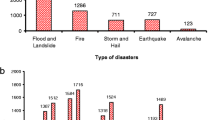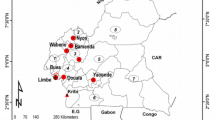Abstract
Natural disasters’ socioeconomic and environmental losses are predicted to rise, unless early warning, full stakeholders and community involvement in the mitigation, adaptation and risk reduction are squarely engaged. The objective of this study is to assess the impact of early alert and community involvement in disaster risk reduction in Nyabihu District, Western Rwanda. A quota sampling method was employed to obtain a sample of 240 households from 12 sectors of Nyabihu District in 2015. A structured questionnaire was used, and the field data collected were computed by using SPSS16.0 for Windows. The results indicated that, as stated by respondents, the frequently experienced disasters are floods (51.25%) and landslides (42.08%). However, as asserted by 68% of informants, disaster-related information is communicated through radio channels after the occurrence, while 29% of them declared that disaster information is disseminated before occurrence, which implies the rising level of risk vulnerability and incidences to the community due to lack of early warning. A lower community participation in disaster risk preparedness and mitigation was noticed (6.2%) while 31.6% mentioned taking part in activities aimed at coping with the aftermath (adaptation). Moreover, disaster risk reduction government policies are preferentially implemented (42.9%) other than considering the community’s knowledge (14.1%). To halt the gradual increase in disasters’ associated risks and losses, it is suggested to introduce disaster-related training across the community, introduce disaster courses from elementary schools and integrate the community in decision-making process.





Similar content being viewed by others
References
Altun B, Arici M, Nergizoglu G, Derici Ü, Karatan O, Turgan Ç, Sindel S, Erbay B, Hasanoglu E, Çaglar S (2005) Prevalence, awareness, treatment and control of hypertension in Turkey (the PatenT study) in 2003. J Hypertens 23(10):1817–1823
Ansoms A, Rostagno D (2012) Rwanda’s vision 2020 halfway through: what the eye does not see. Rev Afr Polit Econ 39(133):427–450
Apronti PT, Osamu S, Otsuki K, Kranjac-Berisavljevic G (2015) Education for disaster risk reduction (DRR): linking theory with practice in Ghana’s basic schools. Sustainability 7(7):9160–9186
Asumadu-Sarkodie S, Rufangura P, Jayaweera HM, Owusu PA (2015) Situational analysis of flood and drought in Rwanda. Int J Sci Eng Res 6(8):960–970
Benson C, Clay EJ (2004) Understanding the economic and financial impacts of natural disasters (No. 4). World Bank Publications, Washington, DC
Berke PR (1995) Natural-hazard reduction and sustainable development: a global assessment. J Plan Lit 9(4):370–382
Bizimana JP, Schilling M (2009) Geo-information technology for infrastructural flood risk analysis in unplanned settlements: a case study of informal settlement flood risk in the Nyabugogo flood plain, Kigali City, Rwanda. In: Showalter PS, Lu Y (eds) Geospatial techniques in urban hazard and disaster analysis. Springer, Netherlands, pp 99–124
Bizimana H, Sönmez O (2015) Landslide occurrences in the hilly areas of Rwanda, their causes and protection measures. Disaster Sci Eng 1(1):1–7
Bowling A (2005) Mode of questionnaire administration can have serious effects on data quality. J Public Health 27(3):281–291
Boyko CT, Cooper R (2013) Density and decision-making: findings from an online survey. Sustainability 5(10):4502–4522
Buruchara RA, Sperling L, Ewell P, Kirkby R (2002) The role of research institutions in seed–related disaster relief: seeds of hope experiences in Rwanda. Disasters 26(4):288–301
Cohen MH, d’Adesky A-C, Anastos K (2005) Women in Rwanda: another world is possible. JAMA 294(5):613–615
Conard BR (2013) Some challenges to sustainability. Sustainability 5(8):3368–3381
District N (2013) Nyabihu district development plan 2013–2018, P O. Box 125 Ruhengeri, Western, Rwanda, pp 1–174
Doğulu C, Karanci AN, Ikizer G (2016) How do survivors perceive community resilience? The case of the 2011 earthquakes in Van, Turkey. Int J Disaster Risk Reduct 16:108–114
Edwards D, Mercer N (2013) Common knowledge: the development of understanding in the classroom. Routledge, UK
Few R (2003) Flooding, vulnerability and coping strategies: local responses to a global threat. Prog Dev Stud 3(1):43–58
Flanagan JP (2001) Early warning system for natural and manmade disasters. US Patent 6,169,476, 2 Jan 2001
Gebauer C, Doevenspeck M (2015) Adaptation to climate change and resettlement in Rwanda. Area 47(1):97–104
Haile M (2005) Weather patterns, food security and humanitarian response in sub-Saharan Africa. Philos Trans Royal Soc Lond B Biol Sci 360(1463):2169–2182
Kagabo D, Stroosnijder L, Visser S, Moore D (2013) Soil erosion, soil fertility and crop yield on slow-forming terraces in the highlands of Buberuka, Rwanda. Soil Tillage Res 128:23–29
Kalinba CDN (2011) The role of Rwanda defence forces in disaster management an assessment
Kellenberg DK, Mobarak AM (2008) Does rising income increase or decrease damage risk from natural disasters? J Urban Econ 63(3):788–802
Kelley K, Clark B, Brown V, Sitzia J (2003) Good practice in the conduct and reporting of survey research. Int J Qual Health Care 15(3):261–266
Kelman I, Gaillard J, Lewis J, Mercer J (2016) Learning from the history of disaster vulnerability and resilience research and practice for climate change. Nat Hazards 82(1):129–143
Kiedrzyńska E, Kiedrzyński M, Zalewski M (2015) Sustainable floodplain management for flood prevention and water quality improvement. Nat Hazards 76(2):955–977
Klein RJ, Schipper ELF, Dessai S (2005) Integrating mitigation and adaptation into climate and development policy: three research questions. Environ Sci Policy 8(6):579–588
Læss⊘e J (2010) Education for sustainable development, participation and socio-cultural change. Environ Educ Res 16(1):39–57
Little AW, Green A (2009) Successful globalisation, education and sustainable development. Int J Educ Dev 29(2):166–174
Liu D, Zhang S, Yang H, Jiang Y, Leng X (2015) Application and analysis of debris-flow early warning system in Wenchuan earthquake-affected area. Nat Hazards Earth Syst Sci Discuss 3:5847–5889
Mata-Lima H, Alvino-Borba A, Pinheiro A, Mata-Lima A, Almeida JA (2013) Impacts of natural disasters on environmental and socio-economic systems: what makes the difference? Ambiente Soc 16(3):45–64
Mathbor GM (2007) Enhancement of community preparedness for natural disasters the role of social work in building social capital for sustainable disaster relief and management. Int Soc Work 50(3):357–369
Mercer J (2010) Disaster risk reduction or climate change adaptation: are we reinventing the wheel? J Int Dev 22(2):247–264
Merkouris P (2014) Climate change and natural disasters. In: Fitzmaurice M, Maljean-Dubois S, Negri St (eds) The challenges of environmental protection and sustainable development from Rio to Rio 20. Brezil
Morrow KM, Vargas S, Rosen RK, Christensen AL, Salomon L, Shulman L, Barroso C, Fava JL (2007) The utility of non-proportional quota sampling for recruiting at-risk women for microbicide research. AIDS Behav 11(4):586–595
Munyaneza O, Ndayisaba C, Wali U, Mulungu M, Dulo O (2011) Integrated flood and drought management for sustainable development in the Kagera River basin. Nile Water Sci Eng J 4(1):60–70
Musana A, Mutuyeyezu A (2011) Impact of climate change and climate variability on altitudinal ranging movements of mountain gorillas in Volcanoes National Park, Rwanda (Externship Report). The International START Secretariat, USA
Nduwayezu E, Derron M-H, Jaboyedoff M, Penna I, Kanevski M (2014) Some aspects of risks and natural hazards in the rainfall variability space of Rwanda. In: Paper read at EGU general assembly conference abstracts
Nkwunonwo U, Whitworth M, Baily B (2016) urban flood risk management in the Lagos region of Nigeria. Nat Hazards Earth Syst Sci 16:349–369
Noy I (2009) The macroeconomic consequences of disasters. J Dev Econ 88(2):221–231
Pearce L (2003) Disaster management and community planning, and public participation: how to achieve sustainable hazard mitigation. Nat Hazards 28(2–3):211–228
Proust K, Newell B, Brown H, Capon A, Browne C, Burton A, Dixon J, Mu L, Zarafu M (2012) Human health and climate change: leverage points for adaptation in urban environments. Int J Environ Res Public Health 9(6):2134–2158
REMA (2011) Atlas of Rwanda’s changing environment, implication for climate change resilience, Rwanda Environment Management Authority P.O. Box 7436 Kigali, Rwanda
Rugigana E, Nyirazinyoye L, Umubyeyi A, Nsengiyumva J, Kanyandekwe C, Ntahobakulira I (2014) Prioritization of disasters and their management in Rwanda. East Afr J Public Health 10(2):429–439
Satapathy S, Walia A (2007) Affected parents’ and other stakeholders’ perception of a fire disaster management in India: a situational analysis. Disaster Manag Response 5(4):111–118
Sättele M, Bründl M, Straub D (2016) Quantifying the effectiveness of early warning systems for natural hazards. Nat Hazards Earth Syst Sci 16(1):149–166
Schipper L, Pelling M (2006) Disaster risk, climate change and international development: scope for, and challenges to, integration. Disasters 30(1):19–38
Sims H, Vogelmann K (2002) Popular mobilization and disaster management in Cuba. Public Adm Dev 22(5):389
Sneddon C, Howarth RB, Norgaard RB (2006) Sustainable development in a post-Brundtland world. Ecol Econ 57(2):253–268
Stajura M, Glik D, Eisenman D, Prelip M, Martel A, Sammartinova J (2012) Perspectives of community-and faith-based organizations about partnering with local health departments for disasters. Int J Environ Res Public Health 9(7):2293–2311
Thaxton M (2009) Integrating population, health, and environment in Rwanda. Population Reference Bureau, Washington, DC
Tompkins EL, Adger W (2004) Does adaptive management of natural resources enhance resilience to climate change? Ecol Soc 9(2):10
Vunabandi V, Matsunaga R, Markon S, Willy N (2015) Flood sensing framework by arduino and wireless sensor network in Rural-Rwanda. In: 2015 16th IEEE/ACIS international conference on paper read at software engineering, artificial intelligence, networking and parallel/distributed computing (SNPD)
Zimmerman (2012) Rapid risk and capacities assessment and livelihoods profiling in Nyabihu, Musanze and Burera Districts affected by floods and landslides, Kigali-Rwanda, p 53
Acknowledgements
The authors gratefully thank the Univeristy of Chinese Academy of Sciences (CAS) for the Scholarship awarded and the Xinjiang Key Laboratory of Water Cycle and Utilization in Arid Zone for its remarkable assistance through the Grant No. 2012CB956204 provided. Authors also thank local community of Nyabihu District for its participation and provision of the needed information which made this study feasible.
Author information
Authors and Affiliations
Corresponding author
Rights and permissions
About this article
Cite this article
Nahayo, L., Mupenzi, C., Kayiranga, A. et al. Early alert and community involvement: approach for disaster risk reduction in Rwanda. Nat Hazards 86, 505–517 (2017). https://doi.org/10.1007/s11069-016-2702-5
Received:
Accepted:
Published:
Issue Date:
DOI: https://doi.org/10.1007/s11069-016-2702-5




